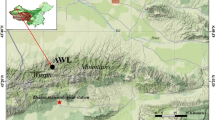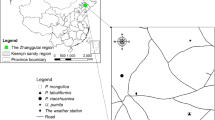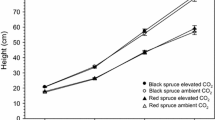Abstract
Qilian juniper (Sabina przewalskii Kom.) and Qinghai spruce (Picea crassifolia Kom.) represent different tree functional types, which can be found extensively in northwestern China. The former is drought-tolerant, whereas the latter is hygrophilous and shade-tolerant. We compared their intrinsic water-use efficiency (iWUE, inferred from carbon isotopic discrimination, δ13C, in their wood) as a function of atmospheric CO2 concentration, [CO2], and climate. δ13C of spruce was consistently about \({1.23\permille}\) higher than that of juniper in semi-arid areas but was lower in arid areas. This difference was stable over time and demonstrated strong cross-correlations between species, although some subtle high-frequency (2 or 3 years) variations existed in both species, suggesting that regional climate may control carbon isotope discrimination. The \({{C_{\rm i}/C_{\rm a}}}\) ratio (the [CO2] values in leaf intercellular and the atmosphere, respectively) of the juniper increased steadily over time, whereas that of the spruce showed a long-term downward trend. IWUE increased at all sites over the 150-year study period, mainly caused by increasing [CO2]. The relationship between iWUE and [CO2] reveals that the spruce was more sensitive than the juniper to increasing [CO2], suggesting a species-specific adaptation to long-term environmental changes. Correlations between the high-frequency variations in stable carbon discrimination (Δ) and climate indicate similar intra-site responses to climate in both species, but different response strengths. Overall, complex interactions of temperature and moisture on stable carbon discrimination during current growth seasons of both species were environmental-determined. Regulation of gas exchange and reduced transpiration may influence water and energy budgets directly; therefore species-dependent responses of trees to elevated CO2 should be considered in future research on global plant physiological ecology.







Similar content being viewed by others
References
Adams HD, Kolb TE (2004) Drought responses of conifers in ecotone forests of northern Arizona: tree ring growth and leaf δ13C. Oecologia 140:217–225
Berninger F, Sonninen E, Aalto T et al (2000) Modeling 13C discrimination in tree rings. Global Biogeochem Cycles 14:213–223
Bert D, Leavitt SW, Dupouey JL (1997) Variations of wood δ13C and water-use efficiency of Abies alba during the last century. Ecology 78(5):1588–1596
Blasing TJ, Solomon AM, Duvick DN (1984) Response functions revisited. Tree-Ring Bull 44:1–15
Cerasoli S, Maillard P, Scartazza A et al (2004) Carbon and nitrogen winter storage and remobilization during seasonal flush growth in two-year-old cork oak (Quercus suber L.) saplings. Ann For Sci 61:721–729
Che KJ, Fu EH, Wang JY (1998) The structure and function of the water conservation forest ecosystems in Qilian Mountains (in Chinese). Sci Silvae Sin 34(5):29–37
Chen T, Chen FH, An LZ et al (2004) Variations of tree-ring and foliar δ13C values of Sabina przewalskii with altitude. J Glaciol Geocryol (in Chinese) 26(6):767–771
Coplen TB (1995) Discontinuance of SMOW and PDB. Nature 375:285
Donovan LA, Ehleringer JR (1994) Potential for selection on plants for water-use efficiency as estimated by carbon isotope discrimination. Am J Bot 81:927–935
Du Q, Sun SZ (1990) Vegetation in the Chaidamu Basin Region and its Utilization (in Chinese). Science Press, Beijing
Duquesnay A, Bréda N, Stievenard M et al (1998) Changes of tree ring δ13C and water-use efficiency of beech (Fagus sylvatica L.) in north-western France during the past century. Plant Cell Environ 21:565–572
Ehleringer JR, Cerling TE (1995) Atmospheric CO2 and the ratio of intercellular to ambient CO2 concentrations in plants. Tree Physiol 15:105–111
FAO (1988) FAO/Unesco Soil Map of the World, Revised legend, with corrections and updates. World Soil Resources Report 60, FAO, Rome
Farquhar GD, O’Leary MH, Berry JA (1982) On the relationship between carbon isotope discrimination and the intercellular carbon dioxide concentration in leaves. Aust J Plant Physiol 9:121–137
Feng XH (1998) Long-term C i /C a response of trees in western North America to atmospheric CO2 concentration derived from carbon isotope chronologies. Oecologia 117:19–25
Feng XH (1999) Trends in intrinsic water-use efficiency of natural trees for the past 100–200 years: a response to atmospheric CO2 concentration. Geochim Cosmochim Acta 63:1981–1903
Ferrio JP, Florit A, Vege A et al (2003) δ13C and tree-ring width reflected different drought responses in Quercus ilex and Pinus halepensis. Oecologia 137:521–518
Francey RJ, Allison CE, Etheridge DM et al (1999) A 1000 year high precision record of δ13C in atmospheric CO2. Tellus Ser B 51:170–193
Francey RJ, Farquhar GD (1982) An explanation of δ13C/12C variations in tree rings. Nature 297:28–31
Freyer HD, Belcay N (1983) 13C/12C records in Northern Hemisphere trees during the past 500 years- anthropogenic impact and climatic superposition. J Geophy Res 88(C11):6844–6852
Gou XH, Chen FH, Yang MX et al (2005) Climatic response of thick leaf spruce (Picea crassifolia) tree-ring width at different elevations over Qilian Mountains, northwestern China. J Arid Environ 61(4):513–524
Green JW (1963) Wood cellulose. In: Whistler RL (ed) Methods of carbohydrate chemistry III. Academic Press, London, pp 9–21
Guy RD, Holowachuk DL (2001) Population differences in stable carbon isotope ratios of Pinus contorta Dougl. ex Loud.: relationship to environment, climate of origin, and growth potential. Can J Bot 79:274–283
Heaton THE (1999) Spatial, species and temporal variations in the 13C/12C ratios of C3 plants: implications for palaeodiet studies. J Archaeol Sci 26:637–649
Hemming DL, Switsur VR, Waterhouse JS et al (1998) Climate and the stable carbon isotope composition of tree ring cellulose: an intercomparison of three tree species. Tellus Ser B 50:25–32
Hietz P, Wanek W, Dunisch O (2005) Long-term trends in cellulose δ13C and water use efficiency of tropical Cedrela and Swietenia from Brazil. Tree Physiol 25:745–752
Holmes RL (1983) Computer assisted quality control in tree ring dating and measurement. Tree-Ring Bull 43:69–75
Idso SB (1999) The long-term response of trees to atmospheric CO2 enrichment. Glob Change Biol 5:493–495
Körner C, Farquhar GD and Wong SC (1991) Carbon isotope discrimination by plants follows latitudinal and altitudinal trends. Oecologia 88:30–40
Lauteri M, Scartazza A, Guido MC et al (1997) Genetic variation in photosynthetic capacity, carbon isotope discrimination and mesophyll conductance in provenances of Castanea sativa adapted to different environments. Funct Ecol 11:675–683
Leavitt SW, Idso SB, Kimball BA et al (2003) The effect of long-term atmospheric CO2 enrichment on the intrinsic water-use efficiency of sour orange trees. Chemosphere: Global Change Sci 50(1):217–222
Leavitt SW, Lara A (1994) South American trees show declining δ13C trend. Tellus Ser B 46:152–157
Leavitt SW, Newberry T (1992) Systematic of stable carbon isotopic differences between gymnosperm and angiosperm trees. Plant Physiol 11:157–162
Leavitt SW (2006) Isotopic pooling vs. separate analysis with averaging: the fallacy of a significant difference. Paper presented at the 7th international conference on dendrochronology: cultural diversity, environmental variability. Institute of Botany, Chinese Academy Sciences, Beijing, 11–17 June 2006
Liang EY, Liu XH, Yuan YJ et al (2006a) The 1920s drought recorded by tree rings and historical documents in the semi-arid and arid areas of northern China. Clim Change 79: 403−432
Liang EY, Shao XM, Eckstein D et al (2006b) Topography- and species-dependent growth responses of Sabina przewalskii and Picea crassifolia to climate on the northeast Tibetan Plateau. For Ecol Manage 236:268–277 DOI:10.1016/j.foreco.2006.09.016
Liu XH, Qin DH, Shao XM et al (2005) Temperature variations recovered from tree-rings in the middle Qilian Mountains over the last millennium. Sci China Ser D-Earth Sci 48:521–529
Loader NJ, Robertson I, Barker AC et al (1997) An improved technique for the batch processing of small whole wood samples to α-cellulose. Chem Geol 136:313–317
Loader NJ, Robertson I, McCarroll D et al (2003) Comparison of stable carbon isotope ratios in the whole wood, cellulose and lignin of oak tree-rings. Palaeogeogr Palaeoclimatol Palaeoecol 196:395–407
Maillard P, Garriou D, Deléens E et al (2004) The effects of lifting on mobilisation and new assimilation of C and N during regrowth of transplanted Corsican pine seedlings. A dual 13C and 15N labelling approach. Ann For Sci 61(8):795–805
Marshall JD, Monserud RA (1996) Homeostatic gas-exchange parameters inferred from 13C/12C in tree rings of conifers. Oecologia 105:13–21
McCarroll D, Pawellek F (1998) Stable carbon isotope ratios of latewood cellulose in Pinus sylvestris from northern Finland: variability and signal-strength. Holocene 8(6):675–684
McCarroll D, Loader NJ (2004) Stable isotopes in tree rings. Quat Sci Rev 23:771–801
McDowell N, Brooks JR, Fitzgerald SA, et al (2003) Carbon isotope discrimination and growth response of old Pinus ponderosa trees to stand density reductions. Plant Cell Environ 26:631–644
Meinzer FC, Goldstein G, Holbrook NM et al (1993) Stomatal and environmental control of transpiration in a lowland tropical forest tree. Plant Cell Environ 16:429–436
Pederson N, Cook ER, Jacoby GC et al (2004) The influence of winter temperatures on the annual radial growth of six northern range margin tree species. Dendrochronologia 22:7–29
Pilcher JR (1990) Sample preparation, cross-dating, and measurement. In: Cook ER, Kairiukstis LA (eds) Methods of dendrochronology: application in the environmental sciences. Kluwer, Amsterdam, pp 40–51
Polley HW, Johnson HB, Marino BD et al (1993) Increase in C3 plant water-use efficiency and biomass over glacial to present CO2 concentrations. Nature 361:61–64
Qiang WY, Wang XL, Chen T et al (2003) Variations of stomatal density and carbon isotope values of Picea crassifolia at different altitudes in the Qilian Mountains. Trees 17:258–262
Salas JD (1993) Analysis and modeling hydrologic time series. In: Maidment DR (ed) Handbook of hydrology. McGraw-Hill, New York, pp 19.1–19.72
Sandquist DR, Ehleringer JR (2003) Carbon isotope discrimination differences within and between contrasting populations of Encelia farinose raised under common-environment conditions. Oecologia 134:463–470
Saurer M, Siegwolf RW, Schweingruber FH (2004) Carbon isotope discrimination indicates improving water-use efficiency of trees in northern Eurasia over the last 100 years. Global Change Biol 10:2109–2120
Schleser GH, Bernhardt KG, Hurka H (1989) Climatic adaptability of populations of Diplotaxis erucoides D. C. (Brassicaceae) from Sicily, based on leaf morphology, leaf anatomy and δ13C studies. Int J Biometeorol 33:109–118
Schuster WFS, Sandquist DR, Phillips SL et al (1992) Comparisons of carbon discrimination in populations of arid-land plants differing in lifespan. Oecologia 91:332–337
Shao XM, Huang L, Liu HB et al (2005) Reconstruction of precipitation variation from tree rings in recent 1000 years in Delingha, Qinghai. Sci China Ser D-Earth Sci 48(7):939–949
Stuiver M (1978) Atmospheric carbon dioxide and carbon reservoir change. Science 199:253–258
Waterhouse JS, Switsur VR, Barker AC et al (2004) Northern European trees show a progressively diminishing response to increasing atmospheric carbon dioxide concentrations. Quat Sci Rev 23:803–810
Woodward FI (2002) Potential impacts of global elevated CO2 concentrations on plants. Curr Opin Plant Biol 5:207–211
Woodward FI, Kelly CK (1995) The influence of CO2 concentration on stomatal density. New Phytol 131:311–327
Wullschleger SD, Tschaplinski TJ, Norby RJ (2002) Plant water relations at elevated CO2-implications for water limited environments. Plant Cell Environ 25:319–331
Zhang J, Marshall JD, Jaquish BC (1993) Variation in carbon isotope discrimination and gas exchange in Pseudotsuga menziesii. Oecologia 93:80–87
Zhang QB, Cheng GD, Yao TD et al (2003) A 2326-year tree-ring record of climate variability on the north-eastern Qinghai-Tibetan plateau. Geo Res Lett 30(14) DOI: 10.1029/2003GL017425
Zhang ZH, Wu XD (1997) Climatic reconstruction in Qilian Mountain during the past 700 years using tree-ring data. Chin Sci Bull (in Chinese) n42(8):749–751
Zheng WJ (1983) Tree index of China (in Chinese). China Forest Publishing House, Peking, p 361
Zhou Y, Li S (1990) Forestry in China. Science Press, Beijing
Acknowledgments
This research was supported by the National Natural Science Foundations of China (40501076), the Ministry of Science and Technology of China (Grant No. 2005DIB3G100), and the Import-Talents Program of the Cold and Arid Regions Environmental and Engineering Research Institute (058170), Chinese Academy Sciences, and International Partnership Project of Chinese Academy Sciences (CXTD-Z2005-2), and the foundation of the Key Laboratory of Cryosphere and Environment (058143). The authors gratefully acknowledge Geoff Hart for improvement of the English in the manuscript. We also thank Dr. Lei Huang, Haifeng Zhu, Jicheng He, and others for their help with the fieldwork. We also thank the anonymous reviewers and the editor whose comments and suggestions were helpful in the improvement of the quality of this article.
Author information
Authors and Affiliations
Corresponding author
Rights and permissions
About this article
Cite this article
Liu, X., Shao, X., Liang, E. et al. Species-dependent responses of juniper and spruce to increasing CO2 concentration and to climate in semi-arid and arid areas of northwestern China. Plant Ecol 193, 195–209 (2007). https://doi.org/10.1007/s11258-006-9258-5
Received:
Accepted:
Published:
Issue Date:
DOI: https://doi.org/10.1007/s11258-006-9258-5




